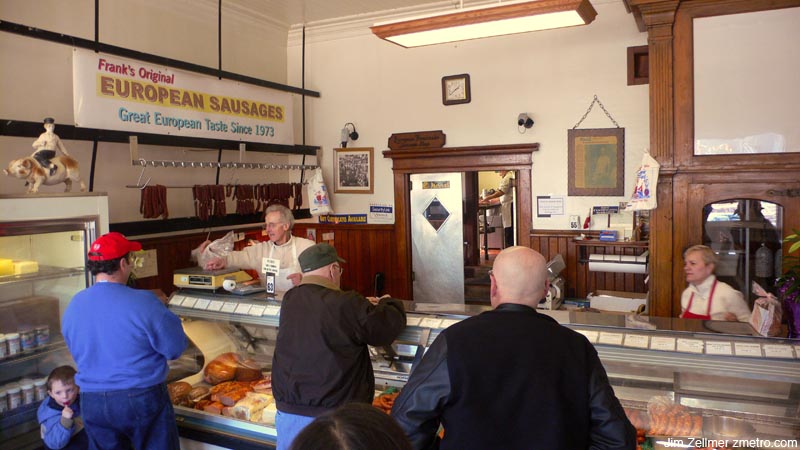Pondering a future for location intelligence is a speculative journey through geographic permanence and human transience that ends with proving location intelligence to be evermore crucial to businesses and governments.
The Canadian postal context
The post office has a natural connection to location and an unbeatable advantage over geo-matics, spatial mapping and so on: postal carriers go regularly to all locations.
Opened in 1755, the first Canadian post office facilitated commerce and nation-building at a time when locating people and places among the buffalo and beaver was a real challenge. By 2005, Canada Post was delivering 11.1-billion letters and packages – about 37-million pieces every day – to over 31-million individual Canadians plus over 1-million businesses and institutions at some 14-million points-of-call.
Canada Post has established an electronic pedigree as well. epostTM serves about 4-million subscribed Canadians, delivering electronic bills for over 90-percent of Canadian large volume mailers. Canada Post also provides both an electronic courier service to securely transmit large electronic documents and an Electronic PostMark.
Out of East Germany via Bulgaria
Two dangling strands of barbed wire have haunted Olaf Hetze for over a quarter century, since his failed attempt to escape from the Communist bloc, not by going over the Berlin Wall but around it by a little-known route through Bulgaria.
Mr. Hetze still believes that he and his girlfriend, Barbara Hille, might have made it if he had managed to cover their tracks better, trimming the loose ends after cutting the top wire of a border fence. If he had, Mr. Hetze said in an interview at his home in Munich earlier this year, he might never have seen the shooting stars of tracer bullets arcing across the night sky, or had to watch his girlfriend twist in the air and fall to the ground, blood rushing out of a life-threatening wound to her shoulder.
But the dangling wire was far from the only reason they failed.
Thanks to the work of a dedicated German researcher, the full extent of the escape attempts through Bulgaria, and the danger, is just now coming to light. At least 4,500 people tried to escape over the Bulgarian border during the cold war, estimated the researcher, Stefan Appelius, a professor of political science at Oldenburg University. Of those, he believes that at least 100 were killed, but no official investigation has ever been undertaken.
The death and life of the American newspaper
The American newspaper has been around for approximately three hundred years. Benjamin Harris’s spirited Publick Occurrences, Both Forreign and Domestick managed just one issue, in 1690, before the Massachusetts authorities closed it down. Harris had suggested a politically incorrect hard line on Indian removal and shocked local sensibilities by reporting that the King of France had been taking liberties with the Prince’s wife.
It really was not until 1721, when the printer James Franklin launched the New England Courant, that any of Britain’s North American colonies saw what we might recognize today as a real newspaper. Franklin, Benjamin’s older brother, refused to adhere to customary licensing arrangements and constantly attacked the ruling powers of New England, thereby achieving both editorial independence and commercial success. He filled his paper with crusades (on everything from pirates to the power of Cotton and Increase Mather), literary essays by Addison and Steele, character sketches, and assorted philosophical ruminations.
Gasoline Tax Comparison
Via The Economist.
Swapping homes helps people see faraway places
When Kate Pavao and Aaron Lazenby moved into their three-bedroom condo in Bernal Heights two years ago, they knew they were making sacrifices. One of them was that there would be no long Hawaiian vacations anytime in the near future.
But then the couple found themselves vacationing in Oahu for three weeks with their 4-year-old daughter, Coco.
They didn’t hit the lottery. No rich relative died and left them money. Instead, Pavao and Lazenby discovered what hundreds of Bay Area residents already know. To take your dream vacation, you don’t have to pay an arm and a leg. You just have to be willing to share your home.
Thanks to the Internet, home exchange programs have proliferated over the past decade, offering Bay Area residents a way to leverage their biggest investment into dream vacations. And, because they live in one of the post popular places on Earth, they can easily swap their homes for the best locales. Potrero Hill for Paris anyone?
“It really speaks to the pragmatist in me,” said Pavao, 33. “You don’t have to leave your house empty, you don’t have to pay for a cat-sitter. We’re paying a lot of money for this place every month. It’s silly for it not to be used.”
On the Cheap Dollar and Travel to Europe
Just when I was getting used to the idea that a euro should cost $1.20, our dollar plummets 20 percent, and now a euro costs $1.55. Don’t expect our currency to recover any time soon because, frankly, we’re not as rich as we think we are.
But 12 million Americans – the vast majority of them normal working people – had a blast in Europe in 2007. So don’t mope. Just get smart and stretch that wimpy little dollar. To help you keep your travel dreams affordable in 2008, here are ways you can take back that 20 percent drop in your dollar’s value – and have a more rewarding trip.
1. A bed and breakfast offers double the warmth and cultural intimacy for half the price of a hotel. You’ll find them in most countries if you know the local word: Husrom is Norwegian for sobe, which is Slovenian for Zimmer, which is German for bed and breakfast (literally, “room”). In Haarlem, in the Netherlands, I save 33 percent by staying a 10-minute walk from the center and paying 55 euros for a double room with a shower, rather than on the square in the cheapest hotel in town, which runs 85 euros for a double with shower.
My Trust in My Lord
Look: I believe in Him. It’s that simple and that complex. I believe in Jesus Christ, the Second Person of the Blessed Trinity, the God Man who came to earth, born as a tiny baby and then lived over thirty years in our midst. I believe in what we celebrate this week: the scandal of the cross and the miracle of the Resurrection. My belief is total. And I know that I cannot convince anyone of it by reason, anymore than an atheist can convince me, by reason, that there is no God.
A long life of historical study and biblical research led me to my belief, and when faith returned to me, the return was total. It transformed my existence completely; it changed the direction of the journey I was traveling through the world. Within a few years of my return to Christ, I dedicated my work to Him, vowing to write for Him and Him alone. My study of Scripture deepened; my study of New Testament scholarship became a daily commitment. My prayers and my meditation were centered on Christ.
And my writing for Him became a vocation that eclipsed my profession as a writer that had existed before.
Why did faith come back to me? I don’t claim to know the answer. But what I want to talk about right now is trust. Faith for me was intimately involved with love for God and trust in Him, and that trust in Him was as transformative as the love.
Clusty Search: Anne Rice.
Milwaukee Art Museum VR Scene

Click for a full screen VR view.
There are some flaws in this hand held scene, but it’s a pleasant view of a spectacular space, particularly the day before our latest snowstorm.
Scenes

Ho Chunk Honeys?



